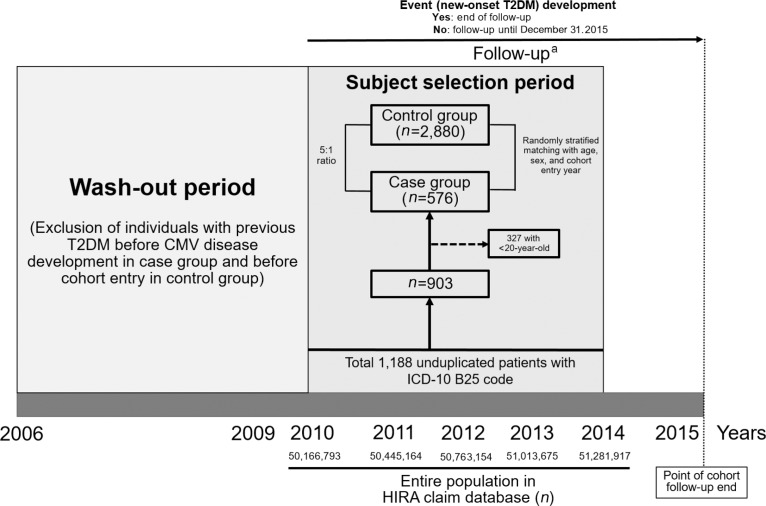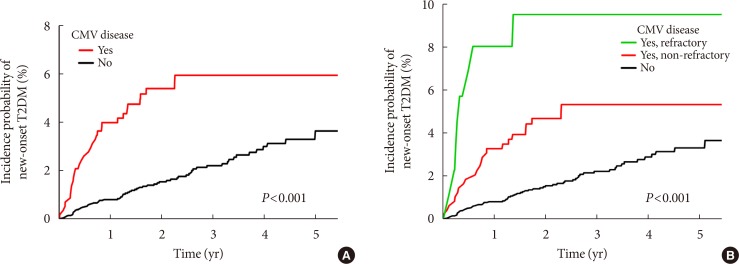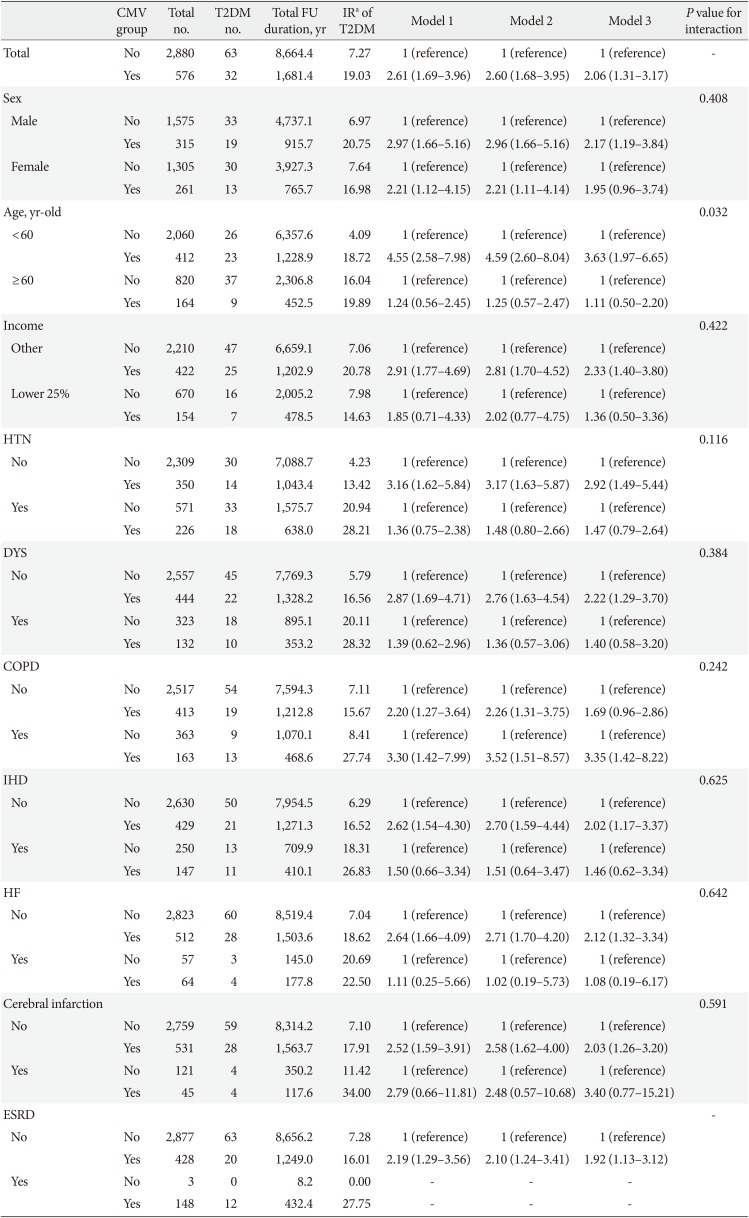1. Kumar A, Herbein G. Epigenetic regulation of human cytomegalovirus latency: an update. Epigenomics. 2014; 6:533–546. PMID:
25431945.

2. Poole E, Sinclair J. Sleepless latency of human cytomegalovirus. Med Microbiol Immunol. 2015; 204:421–429. PMID:
25772624.

3. Cannon MJ, Schmid DS, Hyde TB. Review of cytomegalovirus seroprevalence and demographic characteristics associated with infection. Rev Med Virol. 2010; 20:202–213. PMID:
20564615.

4. Mason GM, Jackson S, Okecha G, Poole E, Sissons JG, Sinclair J, Wills MR. Human cytomegalovirus latency-associated proteins elicit immune-suppressive IL-10 producing CD4+ T cells. PLoS Pathog. 2013; 9:e1003635. PMID:
24130479.

5. Bego M, Maciejewski J, Khaiboullina S, Pari G, St Jeor S. Characterization of an antisense transcript spanning the UL81-82 locus of human cytomegalovirus. J Virol. 2005; 79:11022–11034. PMID:
16103153.

6. Jenkins C, Abendroth A, Slobedman B. A novel viral transcript with homology to human interleukin-10 is expressed during latent human cytomegalovirus infection. J Virol. 2004; 78:1440–1447. PMID:
14722299.

7. Nikolich-Zugich J, van Lier RAW. Cytomegalovirus (CMV) research in immune senescence comes of age: overview of the 6th International Workshop on CMV and Immunosenescence. Geroscience. 2017; 39:245–249. PMID:
28624867.

8. La Rosa C, Diamond DJ. The immune response to human CMV. Future Virol. 2012; 7:279–293. PMID:
23308079.

9. Willis EL, Eberle R, Wolf RF, White GL, McFarlane D. The effects of age and cytomegalovirus on markers of inflammation and lymphocyte populations in captive baboons. PLoS One. 2014; 9:e107167. PMID:
25244034.

10. Holtappels R, Pahl-Seibert MF, Thomas D, Reddehase MJ. Enrichment of immediate-early 1 (m123/pp89) peptide-specific CD8 T cells in a pulmonary CD62L(lo) memory-effector cell pool during latent murine cytomegalovirus infection of the lungs. J Virol. 2000; 74:11495–11503. PMID:
11090146.
11. Karrer U, Sierro S, Wagner M, Oxenius A, Hengel H, Koszinowski UH, Phillips RE, Klenerman P. Memory inflation: continuous accumulation of antiviral CD8+ T cells over time. J Immunol. 2003; 170:2022–2029. PMID:
12574372.
12. Ouyang Q, Wagner WM, Wikby A, Walter S, Aubert G, Dodi AI, Travers P, Pawelec G. Large numbers of dysfunctional CD8+ T lymphocytes bearing receptors for a single dominant CMV epitope in the very old. J Clin Immunol. 2003; 23:247–257. PMID:
12959217.
13. Halenius A, Hengel H. Human cytomegalovirus and autoimmune disease. Biomed Res Int. 2014; 2014:472978. PMID:
24967373.

14. Ji YN, An L, Zhan P, Chen XH. Cytomegalovirus infection and coronary heart disease risk: a meta-analysis. Mol Biol Rep. 2012; 39:6537–6546. PMID:
22311014.

15. Esser N, Legrand-Poels S, Piette J, Scheen AJ, Paquot N. Inflammation as a link between obesity, metabolic syndrome and 2 diabetes. Diabetes Res Clin Pract. 2014; 105:141–150. PMID:
24798950.
16. Grossmann V, Schmitt VH, Zeller T, Panova-Noeva M, Schulz A, Laubert-Reh D, Juenger C, Schnabel RB, Abt TG, Laskowski R, Wiltink J, Schulz E, Blankenberg S, Lackner KJ, Munzel T, Wild PS. Profile of the immune and inflammatory response in individuals with prediabetes and type 2 diabetes. Diabetes Care. 2015; 38:1356–1364. PMID:
25877811.

17. Griffin SJ, Leaver JK, Irving GJ. Impact of metformin on cardiovascular disease: a meta-analysis of randomised trials among people with type 2 diabetes. Diabetologia. 2017; 60:1620–1629. PMID:
28770324.

18. Abdel-Moneim A, Bakery HH, Allam G. The potential pathogenic role of IL-17/Th17 cells in both type 1 and type 2 diabetes mellitus. Biomed Pharmacother. 2018; 101:287–292. PMID:
29499402.

19. Szabo M, Mate B, Csep K, Benedek T. Genetic approaches to the study of gene variants and their impact on the pathophysiology of type 2 diabetes. Biochem Genet. 2018; 56:22–55. PMID:
29143895.

20. Kerru N, Singh-Pillay A, Awolade P, Singh P. Current anti-diabetic agents and their molecular targets: a review. Eur J Med Chem. 2018; 152:436–488. PMID:
29751237.

21. Ashoori MR, Rahmati-Yamchi M, Ostadrahimi A, Fekri Aval S, Zarghami N. MicroRNAs and adipocytokines: promising biomarkers for pharmacological targets in diabetes mellitus and its complications. Biomed Pharmacother. 2017; 93:1326–1336. PMID:
28747014.

22. Lohr JM, Oldstone MB. Detection of cytomegalovirus nucleic acid sequences in pancreas in type 2 diabetes. Lancet. 1990; 336:644–648. PMID:
1975850.

23. Seo JY, Yaneva R, Hinson ER, Cresswell P. Human cytomegalovirus directly induces the antiviral protein viperin to enhance infectivity. Science. 2011; 332:1093–1097. PMID:
21527675.

24. Seo JY, Cresswell P. Viperin regulates cellular lipid metabolism during human cytomegalovirus infection. PLoS Pathog. 2013; 9:e1003497. PMID:
23935494.

25. Zhang J, Liu YY, Sun HL, Li S, Xiong HR, Yang ZQ, Xiang GD, Jiang XJ. High human cytomegalovirus IgG level is associated with increased incidence of diabetic atherosclerosis in type 2 diabetes mellitus patients. Med Sci Monit. 2015; 21:4102–4110. PMID:
26717490.

26. Chen S, de Craen AJ, Raz Y, Derhovanessian E, Vossen AC, Westendorp RG, Pawelec G, Maier AB. Cytomegalovirus seropositivity is associated with glucose regulation in the oldest old. Results from the Leiden 85-plus Study. Immun Ageing. 2012; 9:18. PMID:
22929089.

27. Roberts BW, Cech I. Association of type 2 diabetes mellitus and seroprevalence for cytomegalovirus. South Med J. 2005; 98:686–692. PMID:
16108236.

28. Haeseker MB, Pijpers E, Dukers-Muijrers NH, Nelemans P, Hoebe CJ, Bruggeman CA, Verbon A, Goossens VJ. Association of cytomegalovirus and other pathogens with frailty and diabetes mellitus, but not with cardiovascular disease and mortality in psycho-geriatric patients: a prospective cohort study. Immun Ageing. 2013; 10:30. PMID:
23880245.

29. Blum A, Peleg A, Weinberg M. Anti-cytomegalovirus (CMV) IgG antibody titer in patients with risk factors to atherosclerosis. Clin Exp Med. 2003; 3:157–160. PMID:
14648230.

30. Kotton CN, Kumar D, Caliendo AM, Huprikar S, Chou S, Danziger-Isakov L, Humar A. The Transplantation Society International CMV Consensus Group. The Third International Consensus Guidelines on the management of cytomegalovirus in solid-organ transplantation. Transplantation. 2018; 102:900–931. PMID:
29596116.

31. Gomes MB, Cobas RA. Post-transplant diabetes mellitus. Diabetol Metab Syndr. 2009; 1:14. PMID:
19825150.

32. Leung Ki EL, Venetz JP, Meylan P, Lamoth F, Ruiz J, Pascual M. Cytomegalovirus infection and new-onset post-transplant diabetes mellitus. Clin Transplant. 2008; 22:245–249. PMID:
18339147.

33. Kim JA, Yoon S, Kim LY, Kim DS. Towards actualizing the value potential of Korea Health Insurance Review and Assessment (HIRA) data as a resource for health research: strengths, limitations, applications, and strategies for optimal use of HIRA data. J Korean Med Sci. 2017; 32:718–728. PMID:
28378543.

34. Liu J, Kong J, Chang YJ, Chen H, Chen YH, Han W, Wang Y, Yan CH, Wang JZ, Wang FR, Chen Y, Zhang XH, Xu LP, Liu KY, Huang XJ. Patients with refractory cytomegalovirus (CMV) infection following allogeneic haematopoietic stem cell transplantation are at high risk for CMV disease and non-relapse mortality. Clin Microbiol Infect. 2015; 21:1121.e9–1121.e15.

35. Lee YH, Han K, Ko SH, Ko KS, Lee KU. Taskforce Team of Diabetes Fact Sheet of the Korean Diabetes Association. Data analytic process of a nationwide population-based study using national health information database established by National Health Insurance Service. Diabetes Metab J. 2016; 40:79–82. PMID:
26912157.

36. Wang H, Peng G, Bai J, He B, Huang K, Hu X, Liu D. Cytomegalovirus infection and relative risk of cardiovascular disease (ischemic heart disease, stroke, and cardiovascular death): a meta-analysis of prospective studies up to 2016. J Am Heart Assoc. 2017; 6:e005025. PMID:
28684641.

37. American Diabetes Association. 3. 3. Comprehensive medical evaluation and assessment of comorbidities: standards of medical care in diabetes-2018. Diabetes Care. 2018; 41(Suppl 1):S28–S37. PMID:
29222374.
38. Yoneda S, Imagawa A, Fukui K, Uno S, Kozawa J, Sakai M, Yumioka T, Iwahashi H, Shimomura I. A histological study of fulminant type 1 diabetes mellitus related to human cytomegalovirus reactivation. J Clin Endocrinol Metab. 2017; 102:2394–2400. PMID:
28398495.

39. Numazaki K, Goldman H, Wong I, Wainberg MA. Viral infection of human fetal islets of Langerhans. Replication of human cytomegalovirus in cultured human fetal pancreatic islets. Am J Clin Pathol. 1988; 90:52–57. PMID:
2839029.

40. Eckhard M, Martin I, Eich T, Weimer R, Zinn S, Bretzel RG, Brendel MD. Incidence of cytomegalovirus infections after immunosuppression induction in clinical islet transplantation and impact on graft function. Transplant Proc. 2002; 34:1922–1924. PMID:
12176630.









 PDF
PDF ePub
ePub Citation
Citation Print
Print



 XML Download
XML Download